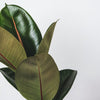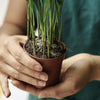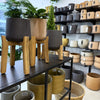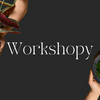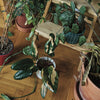Substrate without peat? It works!

Photo: Kemeri National Park in Latvia with natural bogs
When peat is mentioned, few people think that it is one of the few ingredients used in gardening that is at the top of the list of materials that we will soon stop using. To understand the whole thing, let's look at peat in a little more detail.
Peat comes from bogs
Peatlands are specific natural environments that result from the accumulation of peat, an organic material, in wet and acidic conditions. They are wetland habitats found in specific regions around the world, including the Arctic, sub-Arctic regions, mountains, coastal areas and inland peatlands.
Peat is the result of the decomposition of plant materials in anaerobic (without access to oxygen) and acidic conditions. Peat is composed of decomposed bryophytes, grasses, and other plant materials that have accumulated in bogs over many thousands of years. Especially sphagnum - a type of bryophyte that is present in bogs and grows approximately 1 cm per year.
Peatlands have significant ecological value , as they provide a habitat for a number of unique species of plants and animals that are specialized for these conditions. These include, for example, bogs, heathers, mosses, beavers, birds and amphibians, as well as a number of houseplants that originate from these areas.
Peatlands also play an important role in the water and carbon cycle. They are able to store large amounts of water, thereby contributing to surface water regulation and flood prevention. Peatlands also have the ability to bind and store carbon CO2, which contributes to reducing greenhouse gas emissions and mitigating climate change.
Due to their ecological value, it is important to protect peatlands and prevent their destruction. In the past, peat was mined for fuel or for use in horticulture, which had a negative impact on these sensitive natural environments. Today, with a greater emphasis on environmental protection and sustainability, they try to minimize the use of peat and look for alternative substrates and energy sources.
What is peat?
The process of peat formation is slow and takes place over many thousands of years. These are mainly rotted sphagnum roots, which grow only 1 mm per year, and other decaying substances. Due to the speed with which it grows, in this case we are talking about a non-renewable resource. The result of the decomposition of these substances without the presence of oxygen is a "substrate" of brown or black color with a high carbon content.
Is it even possible to grow without peat?
Yes! To grow our plants without peat, we use alternative materials that fulfill what the plants need. For those who do not need to have plants in the substrate at home, we can recommend hydroponic cultivation , which is roughly the most ecological alternative to cultivation, since practically no materials are needed, if we do not include a flower pot (packaging), a few tools and a hydroponic growing medium (keramzite, managreen etc.) Another alternative are substrates that are more ecological and do not have to plunder our land for their extraction. Such materials include, for example,coconut fiber . And that is exactly what we will focus on in today's article. Other alternatives for peat are certainly also compost , different types of bark and other media.

Photo: Blended coir prepared for plants
Tip number 1. Coconut fiber
What makes coconut fiber special? Coconut fiber or substrate has many advantages that ordinary soil does not have, and thanks to them, coconut fiber has been used much more often in growing plants in recent years.
- it retains a large amount of water and nutrients, which it then supplies to the roots
- it is airy and when watered, it supplies oxygen to the roots better
- excess water drains off faster and there is less rotting of the roots due to overflow
- it has an optimal pH for plants and at a different pH level you can work with different fertilizers etc. preparations with which you can change the pH.
- coconut fiber does not create dust and it is cleaner to work with.
- the purchase price of coconut fiber is surprisingly small, considering the amount you can make from one pressed brick, especially if you mix it with other materials.
With its properties, coconut surpasses peat in many ways, but unlike it, it is neutral and contains no nutrients . This needs to be remembered when transplanting into coconut substrates, as it will be necessary to supply nutrients to the plants with fertilizers.
Coconut fiber is a natural raw material that contains the minimum amount of nutrients available to plants. With the exception of sodium (Na) and potassium (K), coconut does not offer significant sources of nutrients. Raw coconut has a high sodium and potassium content compared to peat, resulting in a high cation exchange capacity (CEC). During irrigation, sodium and potassium are gradually released, which bind to the coconut particles replacing ions such as calcium and magnesium. As a result, there can be an excess of potassium and a simultaneous deficiency of calcium or magnesium.
In stores, you can usually getcoconut fiber in pressed bricks or cubes, which just need to be placed in water up to half its height, and after a few rubs, the brick will increase in volume up to 5 times. If you also decide to mix coconut fiber with other materials, you will gain even more volume of the new substrate and you will have a relatively large amount of new medium for transplanting your room plants. If you are afraid that you will overflow the coconut substrate, you can mix it with perlite or add other materials to it to aerate it even more. But keep in mind that coconut fiber can dry out quickly if left unattended for a few days on very steamy days, which is not desirable. Especially with plants that themselves drink a lot of water, e.g. Hibiscus, Chlorophytum variegatum, herbs and others. it is better not to aerate and, on the contrary, rather to mix them with something that will slow down drying even more, e.g. with other soil or fine expanded clay...
In our offer you will find not only coconut fiber, but also mixed substrates without peat , take a look at our offer.
Author: Martin Seidl
-
Posted in
Zajímavosti a tipy
